The original ‘ABC’ protocol was developed to provide an aide memoir for first aiders to use when dealing with a patient. It encompassed the mnemonic for airway, breathing and circulation (‘ABC’); and provided the process to be used when caring for an unconscious or unresponsive patient.
Some aspects of coronary pulmonary resuscitation (CPR) have been in place since the 18th century, with various methods implemented throughout history; however, it was in 1957 when Peter Safar wrote his book ‘ABC’ of Resuscitation that provided the basic aspects of future CPR training, and demonstrated the use of mnemonics for creating a standardized approach to teaching and learning (Mitka, 2003).
Ambulance primary survey concepts have evolved following little structure, other than those used in CPR. Paramedics were historically taught to treat conditions, signs and symptoms rather than using a structured approach to patient assessment. Much of their training was focused on understanding physical signs and symptoms, and linking these to likely causation conditions.
More than 100 years ago, J Scott Riddell (1896) in his book A Manual of Ambulance described the importance of patient assessment, suggesting that:
‘It is the duty of the attendant to carefully watch the patient, and to note any change in his condition. Complaints of pain, changes to breathing or pulses, change in posture, or any particular attitude, sweating, vomiting, rigors or ‘shakes’ should all be watched for and noted.’
Although there were minor developments in the standardization of patient care, approximately 100 years passed before the ABCDE paradigm became standard.
By 2000, the Primary Trauma Care Foundation Advanced Trauma Life Support Group and Resuscitation Council began to advocate for a structured approach to all acute patient assessment, facilitating better communication across all stakeholders involved in patient care.
The primary survey
In 2007, South Western Ambulance NHS Foundation Trust (SWAST) chose to adopt the (C)ABCDE approach to primary survey. This survey process was based on Hodgetts et al (2006) paper ‘ABC’ to <C>ABC: redefining the military trauma paradigm. The trust decided to adopt this structure rather than the recommended ambulance service primary survey model outlined by the Joint Royal Colleges Liasion Committee (JRCALC) in 2006.
The SWAST training department initially implemented the concept due to close relationships with military colleagues who had experience of managing trauma casualties in hostile environments.
The tutors believed that the Hodgetts’ (2006) paradigm was easily transferrable, and necessary, to civilian practice. The paradigm proposes identifying and controlling catastrophic haemorrhage before addressing airway or breathing, ensuring that oxygen was being administered to the body rather than being lost onto the floor.
This approach worked well for SWAST staff since the ambulance trust had already implemented the use of arterial tourniquets in 2006 (Lee et al, 2004); and, the subsequent implementation of the (C)ABCDE approach in 2007 did not require the purchase of any new equipment.
Discussion
Four years after the implementation of (C)ABCDE, the SWAST tutoring team have now taken the opportunity to review, and further refine, their primary survey model to include modern concepts and advances in prehospital care and evidence-based practice. The new algorithm (Figure 1) involves refinements that have been made from experience-based practice (Thompson, 2003), and feedback from front-line staff in the trust who have worked with the previous model.
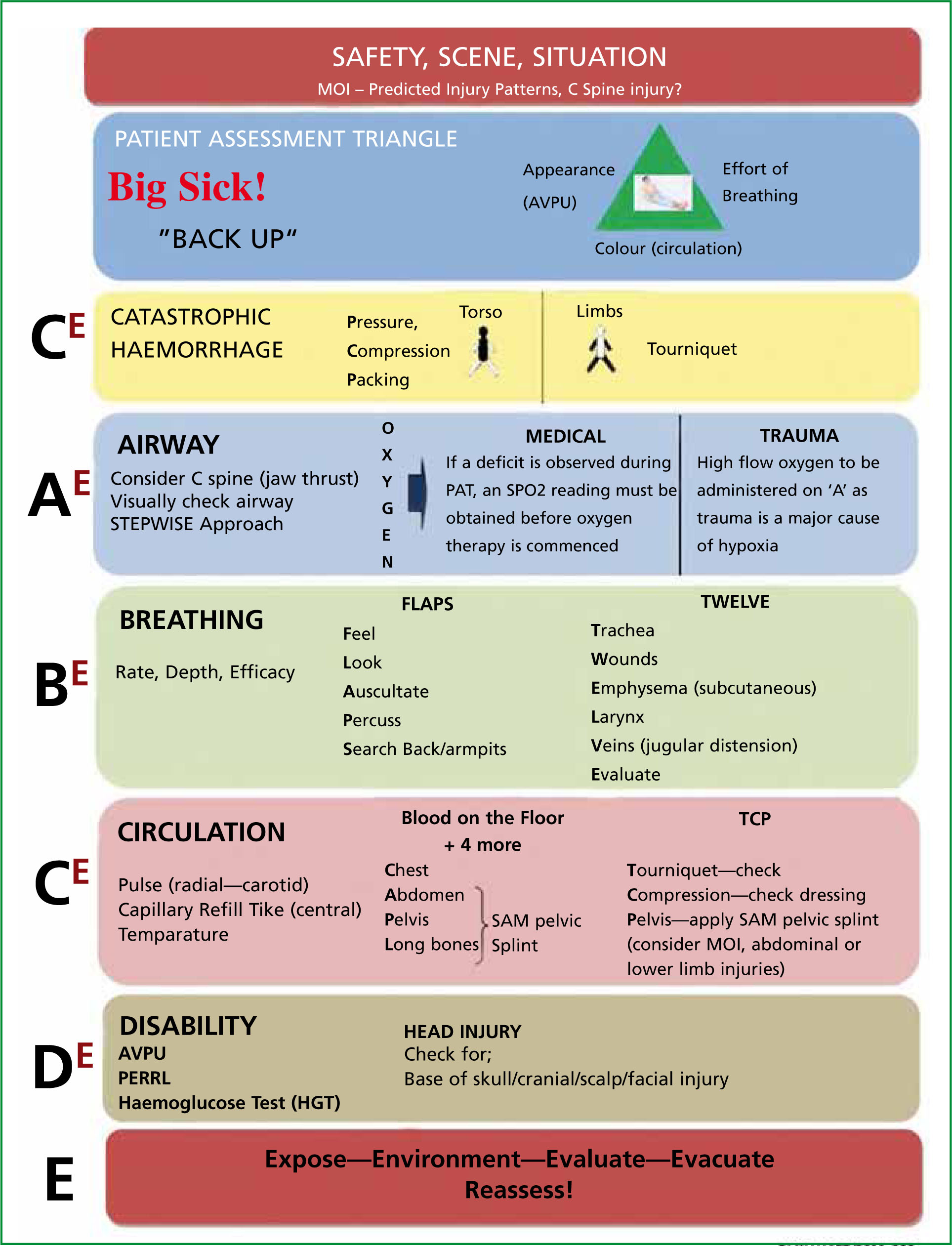
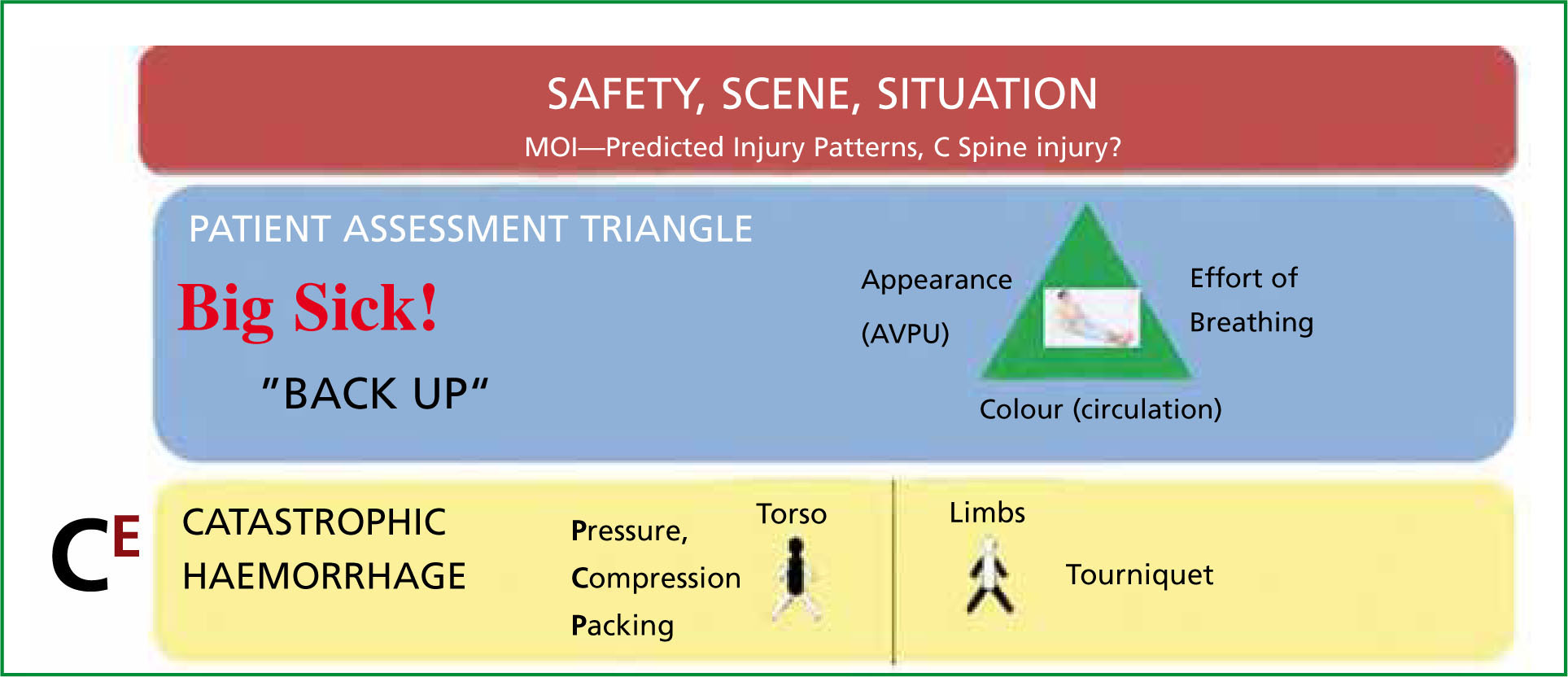
The refinements for 2011 include the use of packing and pelvic splintage. In addition, improvements have been made to the algorithm, including emphasizing compliance with the British Thoracic Guidelines (2008).
Originally the SWAST tutors had wanted to improve the management of trauma patients; however, after only a few weeks of use it became apparent that staff were also using the same process with medical patients. In addition, the taking and recording of clinical observations had been improved by the use of a structured approach to primary survey.
This article aims to outline each aspect of the 2011 primary survey, with the rationale for their inclusion in the algorithm. Next to each of the stages in Figure 1, the letter ‘E’ appears—this is to remind students to examine and evaluate the need for action at each stage of the process before moving on.
Safety, scene, situation
The ‘safety, scene, situation’ (SSS) concept was adopted from prehospital trauma life support (PHTLS) teachings, ensuring that ambulance personnel pay due regard to the safety of themselves, bystanders and patients. The SWAST training team saw no need to adapt this teaching as it ensured that crews observe those safety requirements. In addition, they focus on what really happened, the ages and numbers of patients involved, initial resources, and transportation requirements at the earliest possible opportunity (Department of Health (DH), 2005).
Consideration was given to greater expansion of dynamic risk assessment principles; however, it was felt that these were better suited to dissemination as a teaching point and they were not included in the algorithm. Paramedic instructor colleagues from Ronin in South Africa are using the mnemonic SETTUP that, although not adopted by the tutors in this refinement of the algorithm, is still worthy of discussion (Irvine Smith et al, 2011). The algorithm consists of:
While the SWAST team have chosen not to implement SETUP, they have decided to include this within their teaching.
Mechanism of injury and kinematics of trauma
Kinematics and mechanism of injury have been added as a separate reminder point within the algorithm to ensure practitioners consider the potential pattern of injury. This includes a consideration of potential C spine injury. Literature identifying mechanism of injury, or injury mechanism, became prominent in the mid to late 1980s; with the mechanism of injury being used as a key decision making tool, in addition, as a component of triage for the trauma patient (Boyle, 2007).
The authors of this article would like to raise their concerns that insufficient attention appears to be given to treating, and transporting patients based on mechanism of injury. In addition, they would like to raise their anxiety that in many primary survey methods, insufficient attention is given to this area.
Until recent times, using a ‘worst case scenario,’ treating the mechanism of injury alone, has not been a significant problem. However, the authors of this article recognize that hospital emergency departments (ED) are suffering from overcrowding and extreme pressures; and although many paramedics feel more confident about their ability to make clinical decisions, some patients are still not receiving high quality care.
This may be due to paramedic staff ruling out potential injury due in response to external pressures. The authors suggest, however, that paramedics should not feel under pressure to disregard the decisions that are based on their ‘gut feeling’ or mechanism of injury alone.
The patient assessment triangle
In 2007, a number of SWAST tutors undertook the paediatric education for prehospital providers course at the SWAST Bournemouth ambulance training college. During this course, they were exposed to the paediatric assessment triangle.
The tutors had been seeking methods to explain to novices the ways that the paramedic experiences a ‘gut feeling’, or intuition, that a patient is unwell. They realized that the paediatric assessment triangle could be applied to the adult patient, and seemed to cover the clinical indicators which appeared to build the clinical ‘gut feeling’. In 2007, therefore, this was included in the revised version of the algorithm (Figure 3).
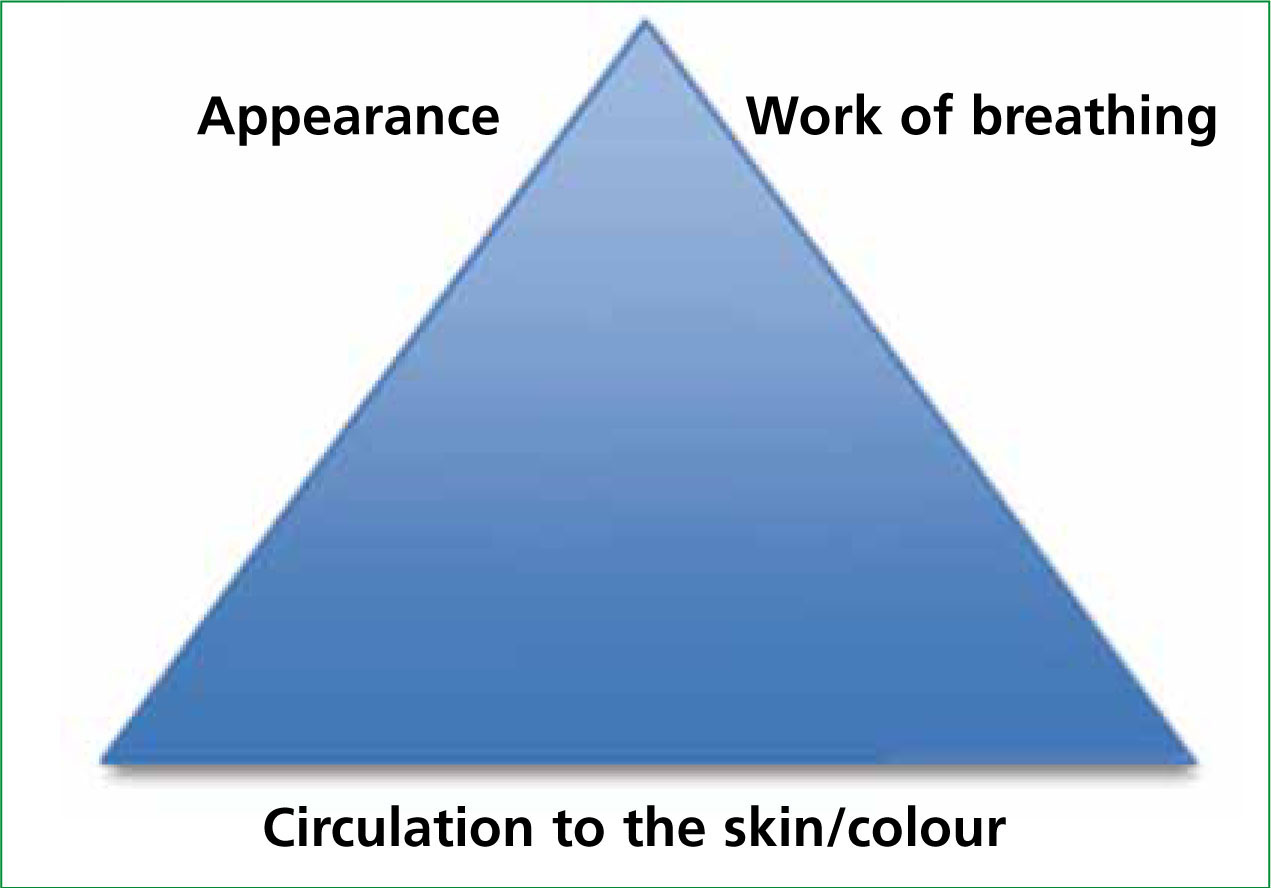
The patient assessment triangle provided a ‘quick look’ at the patient. This initial assessment could be undertaken at a significant distance, before any ‘healing hands’ were applied to the patient; and suggested the likely speed at which key clinical assessments need to be undertaken by the clinician. The general appearance review was something that experienced paramedics often carry out using their clinical intuition.
Clinical intuition based on emotional intelligence (EI) (Gardner, 1983) and experience has always been difficult to teach to new paramedic staff. By focusing on the three components of the patient assessment triangle, the tutors were able to ensure that students understood the implications of an unusual appearance. This may be as simple as observing the patients position, visually identifying neurological abnormalities including unconsciousness, or decerebrate or decorticate rigidities.
The second area within the patient assessment triangle asks the clinician to focus upon increased or decreased work of breathing, including rate, (fast or slow) efficacy (laboured appearance), or identifying unusual noises such as stridor, wheeze or snoring. The third part of the patient assessment triangle requires students to consider the implications of the patient's colour, the circulation to skin, specifically identifying pallor, cyanosis and a flushed appearance.
As a team, there were many debates about what ‘general appearance’ actually meant. The consensus was that by looking at a patients general appearance, we could make decisions such as ‘Is my patient ‘big sick’? ‘Does that therefore require me to undertake speedy life saving interventions’? ‘Is my patient ‘little sick’? In which case a more steady approach to patient assessment can be undertaken.
We are aware that there are links here with concepts of dynamic risk assessment, but this was with a purely clinical focus. In addition, some SWAST tutors were uncomfortable with the language, such as ‘big sick’, feeling that this language over simplified the patient's condition. They suggested that ‘time critical’ should be used, since this encompassed more ‘professional language’.
Following extensive debate, we decided to continue to adopt the ‘big sick’ concept, believing that ‘time critical’ is better placed following patient assessment, and actual identification of life-threatening complications.
(C)ABCDE: (C) catastrophic haemorrhage
As stated earlier, SWAST had been using the (C) ABCDE paradigm since 2007, focusing on the control of catastrophic haemorrhage before establishing the airway. This had always appeared logical to the SWAST team; since there appeared little point in oxygenating a patient whose red cells, and therefore the oxygen carrying capacity, were still leaking onto the floor. However, we have learnt a number of lessons since the adoption of the CABCDE paradigm.
Within SWAST, arterial tourniquet teaching has been changed over recent years to include the concepts of using the arterial tourniquet on single boned limb vs double boned limbs. Staff have been educated about the anatomy and potential difficulties of haemorrhage control in double boned limbs.
Most recently, SWAST has doubled the numbers of tourniquets carried on its vehicles, as their clinical experience has been that, in most cases, more than one tourniquet is often required to control catastrophic haemorrhage; especially in leg amputations. Similarly, more than one limb is involved.
Teaching in SWAST has focused on the use of improvized tourniquets and/or the use of blood pressure cuffs as improvized tourniquets; and using the arterial tourniquet as a windlass to apply pressure to pressure dressings, where haemorrhage control can be achieved in this way.
At the Ambulance 999 Research Forum in 2008, the author presented evidence that the incidence of catastrophic haemorrhage had been limited to 11 uses of the tourniquet in a six-month period in SWAST. This statistic has not changed dramatically since 2008.
An observation that this article would like to highlight relates to possible misunderstanding of how catastrophic haemorrhage is controlled. The authors suggest that when front-line staff were asked how they control catastrophic haemorrhage their stock answer was that they would use the arterial tourniquet. Little consideration had been given to torso bleeds or genital amputations that are becoming increasingly more common as a pattern of injury, certainly within recent train related incidents.
As a result, the SWAST algorithm now separates limb and trunk injury, emphasizing the use of pressure, compression and packing of wounds to control catastrophic haemorrhage. More recently, education for SWAST clinical staff has included the use of haemostatic agents, such as Celox Gauze, and the concepts of packing wounds to the bone.
A and B: focusing on airway and breathing
In prehospital care, the consideration of airway and C spine at the same time is advocated by advanced trauma life support (ATLS) teachings. The rationale being that if there is a likely C spine involvement, then specific C spine control and specific methods to achieve airway management techniques should be used; and others avoided due to potential neck involvement.
The SWAST system (Figure 4) teaches students to visually inspect the airway. In unconscious patients this is easily achieved, however, the SWAST team encourage this practice in conscious patients as well, by asking the patient to stick out their tongue and move it around their lips. Whether this constitutes a definitive airway check could be debated. The rationale has been that if a patient has chewing gum or piercings in their mouth, then these could potentially complicate the airway management in the future, and are easily spotted since patients are inclined to deliberate on how they can hide their gum before sticking out their tongue.
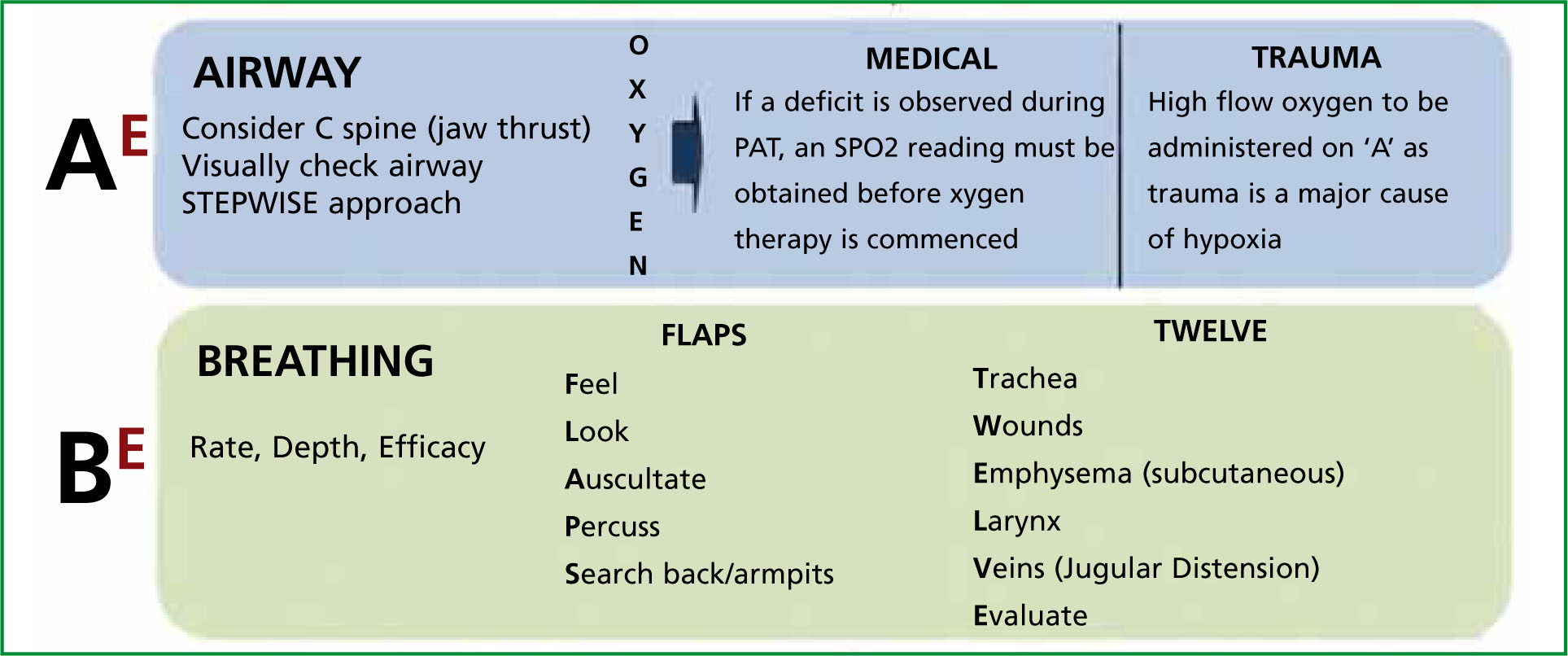
Other reasons for this assessment include the fact that it provides a mini Glasgow Coma Scale (GCS) as we can see if the patient obeys the command. In addition, it gives an insight into cranial nerve function; other benefits include early identification of central cyanosis and hydration, the ‘furry tongue’.
In addition, the authors suggest that wider debate in prehospital care should be given to the over reliance on suction, and under use of the lateral 3/4 prone, or recovery position in unconscious patients. A frustration, and observation, is that many unconscious patients are still being transported ‘fat on their back’; this risks their airway, aspiration and so on. This is a trend that requires more detailed investigation, but remains a significant concern. Transportation of patients in a lateral position is not difficult, and techniques learned from South Africa have suggested that this may even be possible with unconscious patients attached to spine boards. Research in this area is currently in progress in South Africa.
Oxygen—The British Thoracic Society Guidelines
A reminder to use oxygen in trauma, with titration based on oxygen saturations in medical cases, was added to the algorithm to ensure compliance with the British Thoracic Society (BTS) Guidelines (2008). The decision to highlight the difference between medical patients and trauma was introduced following the author's own experience in this area; experience and observation has shown that oxygen is still being applied a littlelate in trauma cases, with SPO2 probes being applied and results awaited prior to oxygen administration.
Assessment of breathing
A great deal of debate has taken place regarding a suitable respiratory assessment during a primary survey. For example, whether it is acceptable to merely undertake an assessment of rate, depth and efficacy. Recording of respiratory rate has been one of the failings of many healthcare professions, and contributes to patient deterioration (suboptimal care); this was one of the earliest issues addressed by the SWAST team in 2007.
Courses, such as the acute life-threatening events recognition and treatment (ALERT) course, have been developed to address poor care in hospital. This has been in response to data showing that some in-hospital cardiac arrests, deaths and admissions to critical care units are avoidable.
ALERT stresses that patients show signs of clinical deterioration for many hours, yet these go undetected or are poorly treated by ward staff.
Suboptimal care is frequently related to poor management of simple aspects of acute care, including: those involving the patient's airway, breathing and circulation, oxygen therapy, fluid balance and monitoring. Other factors include: ineffective organization, lack of knowledge, failure to appreciate the clinical urgency of a situation, lack of adequate supervision, failure to seek advice and poor communication.
The SWAST training team had been working to develop doctors and other health professionals on ALERT courses in the recognition of deterioration; however, they recognize that paramedics and other prehospital staff were not giving due regard to respiratory rate, depth and effort and efficacy.
In addition, the tutoring team had anxieties regarding the lack of standardization of a more detailed respiratory assessment. Therefore, a military mnemonic ‘FLAPS TWELVE’ was introduced in the earlier (2007) version of the system. This was designed to be undertaken after rate, depth and efficacy had been undertaken, and students are encouraged to:
The ‘TWELVE’ part of the mnemonic was included within JRCALC in 2006, and encouraged the student to establish if:
They must evaluate the findings of the above assessment. The training team have considered simplifying this assessment to match modern military teaching, turning the ‘TWELVE’ into ‘TEN’ including: trachea, emphysema, and neck. The consensus decision was that our practitioners are familiar with the concept of ‘TWELVE’, and no change was recommended.
Circulation
The basic assessments of circulation (Figure 5) within a primary survey are the assessment of pulse, rate rhythm and character and volume, and the assessment of capillary refill. In addition, The SWAST tutors include a ‘quick check’ of skin temperature; what is its texture, is it cold and clammy, wet, dry, and so on.
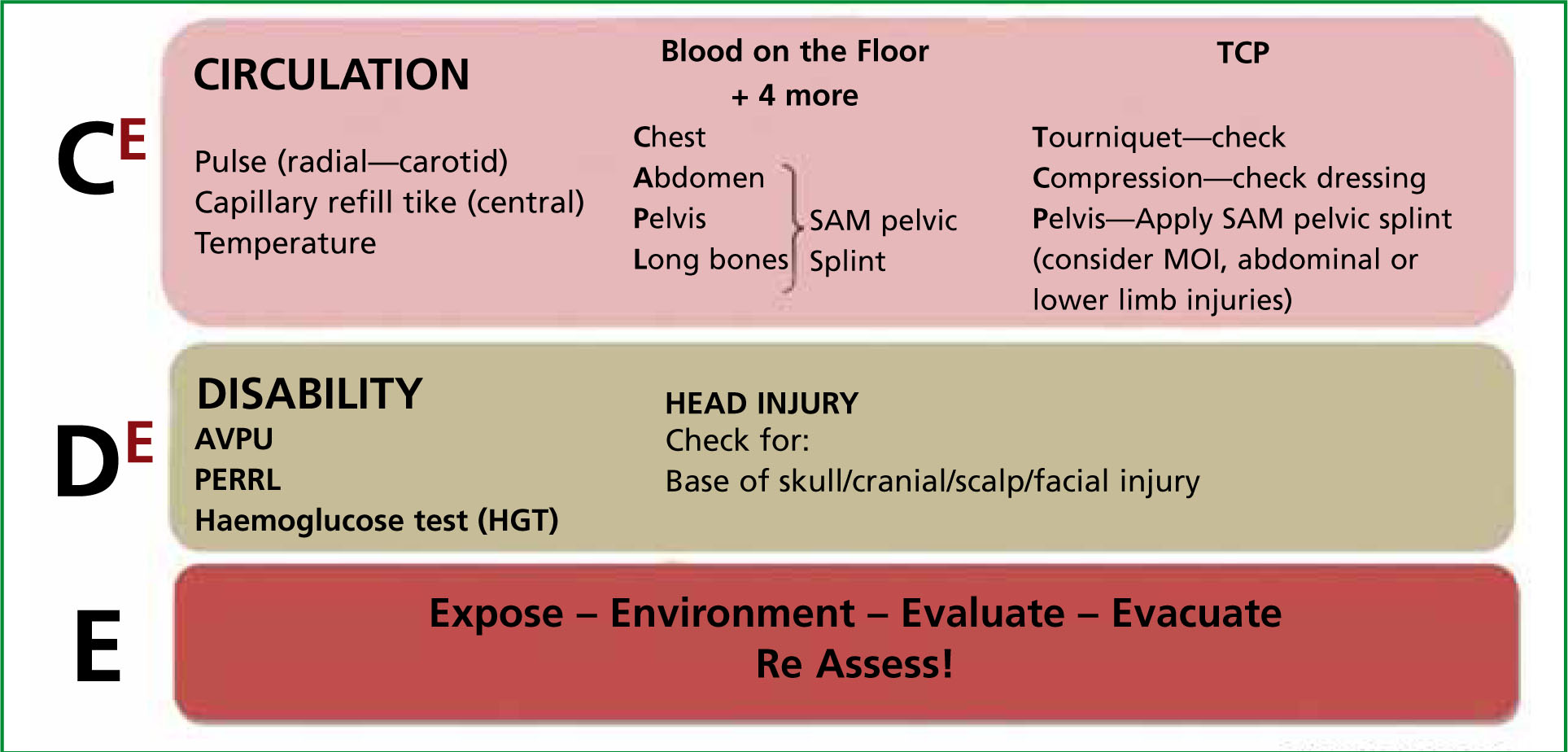
This is not to be confused with the taking of a core temperature, which, it felt by the training team should be included in the Secondary Survey Assessment. This approach is consistent with that proposed by the ALERT course and the Resuscitation Council (2005).
Blood on the floor and four more: concealed haemorrhage check
The Resuscitation Council (UK) (2005) advised staff to ‘remember that intra-thoracic, intra-abdominal or pelvis blood loss may be significant.’ In addition, the analogy of ‘blood on floor and four more’ does require the student to consider concealed haemorrhage.
It is this concept of looking for, and actively searching for, signs of concealed haemorrhage that has saved many lives within SWAST. We require clinical staff to re-check the floor and the patient's clothing for signs of haemorrhage that could have been missed. In addition, they check for blood loss in the chest; this has normally been completed with the breathing assessment. They are instructed to palpate the abdomen, and consider the likelihood of pelvic involvement. Lastly they assess the long bones, specifically the thighbones, signs of fracture and/or swelling.
Tourniquet, compression, pelvis (TCP)
Within the checking of circulation, there is a requirement for a re-checking of the tourniquet which is advocated during the circulation reassessment. The arterial tourniquet is often applied at a time when sympathetic tone is raging through the body, and that once the patient begins to relax further, or has received pain relief, further bleeding can occur requiring the application of a second tourniquet, or the extra tightening of the original one.
The students are encouraged to check the dressings again as any ‘blood lost to the body is lost forever’. The SWAST team are anxious to ensure, as much as possible, that all blood is retained in the patients circulation. Paramedic staff and students are, therefore, encouraged to check that the dressings are effective, and working to control haemorrhage not just collect it in dressings.
A relatively new addition to our practice has been the addition of pelvic binders, the SAM pelvic splint, to control possible pelvic bleeding. The SAM splint safely and effectively reduces and stabilizes open-book pelvic ring fractures; and it allows the practitioner to stabilize pelvic fractures during the critical ‘golden hour’ following severe trauma by providing a circumferential binder around the patient's hips. Our experience is that the pelvis is not always splinted until quite late in the patient treatment process, but the authors of this article have emphasized that pelvic binding is part of haemorrhage control and should be considered as part of circulatory checks.
Disability: AVPU mnemonic
The assessment of disability, neurological status (Figure 4) is undertaken using the AVPU mnemonic; and the patient's pupils are assessed using the mnemonic PERRL (Kugler, 2009)— the pupils equal round and reactive to light. The SWAST tutors spent some time considering whether we should have added an extra ‘A’ for ‘accommodation’, the ability of the eyes to focus on objects that are close up and far away, making the mnemonic into PERRLA. The team felt that this was unnecessary, since this is a primary survey designed to consider initial life-threatening conditions.
An eye examination is performed to check how someone's nervous system is functioning, especially after a head injury or during serious illness. The eye examination would be abnormal if the pupils are:
Haemoglucose test: HGT
Blood glucose testing as part of a primary survey is not something that immediately comes to mind. However, for many paramedics this has become a standard observation as common as counting breathing or heart rate. A number of paramedic calls are to patients with an altered mental status, and a simple assessment using a blood glucose monitor assists the paramedic to excluding hypoglycaemia/ hyperglycaemia as a potential cause of the altered level of consciousness within the primary survey.
Mattila et al (2004) suggest that a HGT test may be a cost-effective way of considering non-conveyance. Paramedics in the South West have a strong record of monitoring blood glucose in a variety of situations including stroke, diabetes and overdose cases.
A new addition to the algorithm has encouraged students to undertake a check for a concealed injury to the head; specifically looking for boggy masses, bruising behind the ears and blood or cerebro-spinal fluid (CSF) in the ear canal, nose or other areas. The paramedic is also required to actively seek concealed skull or scalp injury.
A recent case reported to the health professions council (HPC) identified a case where a UK-based paramedic was alleged to have carried out a head injury assessment in a less thorough way than they should have done. In consequence they had not noticed a significant injury. It is the learning points from this event and others that lead to its inclusion in the algorithm.
Expose
‘Expose’ (Figure 5) was included in the algorithm to remind students that there is a need to expose and examine the whole patient due to the fact that a number of concealed injuries can be missed (Committee on Trauma, American College of Surgeons, 2008).
In addition, we have included ‘environment’, as in a primary survey, the patients condition may have been caused, or affected, by the environment in which they find themselves (Armal et al, 2007). This serves as a reminder for the paramedic to think about blanketing if not have not already done so. In addition, we have added ‘evaluate’ as we need to re-evaluate the patient to see where we are and what the significance of our findings are.
This final review of the primary survey encourages us to denote whether the patient has any of the ‘time-critical’ components requiring urgent attention and admission. However, the authors would also like to initiate wider discussions among paramedics of the concept of ‘primary survey positive patients’ and ‘primary survey negative patients’.
This concept is reliant on all health professionals using a similarly structured approach. Finally, we need to ‘evacuate’ to the appropriate treatment centre, or not, since paramedics do not take every patient to hospital these days; conveyance in SWAST is approximately 60%.
Conclusion
Since introducing the structured primary survey, we have noticed improved patient assessment, and an improvement in the taking of clinical observations among our clinicians. The CABCDE approach has become the template on which all patient education is based, ensuring that our students are versed in the rationale for the assessments that they are making. Our approach has been influenced by the military, specifically tourniquets and packing; in addition it has been shaped by 4 years of personal experience.
To become proficient with the CABCDE approach proposed by SWAST clinicians need regular practice and an understanding of the rationale for exclusion and inclusion of the key components. The authors hope that this article serves to create debate amongst our peers.
